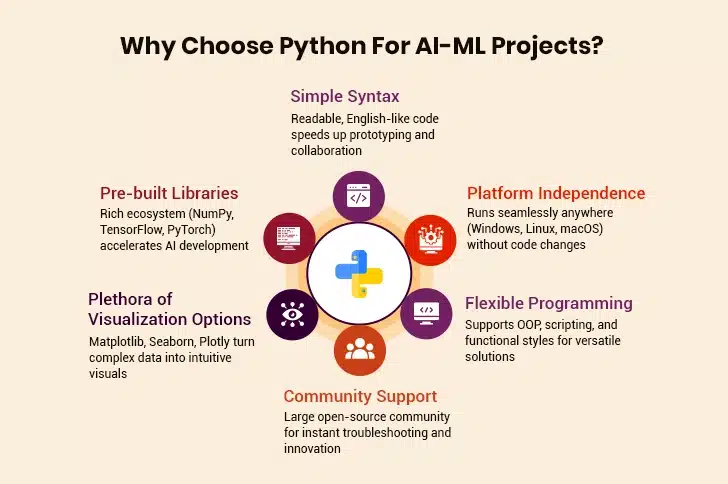None of us can deny the ubiquity of artificial intelligence. The modern world is teeming with applications that use AI. Think about recommendation engines in ecommerce platforms, virtual assistants delivering round-the-clock support on websites, or search engines providing the most relevant results for any query.
A PwC study shows AI could add $15.7 trillion to the world economy by 2030. This would boost global GDP by a substantial 14%. This transformation will affect nearly every industry.
So, what exactly is artificial intelligence? At its core, artificial intelligence seeks to build intelligent software and machines capable of emulating advanced human behaviors: thinking, reasoning, predicting, and judgment. Within this expansive realm, machine learning emerges as a key player. Machine learning is a subset of AI where machines learn from data instead of following rigid programming rules.
The language chosen for programming AI and ML solutions plays a key role in realizing these goals. Among the many languages available, Python is the top choice for most developers. Java follows closely behind, along with R and some older languages. Other options like Scala or C++ are used too. But Python’s simplicity and flexibility make it the language of choice.
Table of Contents
Key Reasons for Choosing Python for AI-ML Solutions
How Python Compares with Other AI Languages
Key Reasons for Choosing Python for AI-ML Solutions
The preference for Python in artificial intelligence programming is not arbitrary; rather, it is rooted in its numerous advantages. Why do experts prefer artificial intelligence with Python? Let’s delve into the key benefits of using Python for machine learning.
1. Large Range of Available Libraries
Python probably has the most extensively tested and well-structured environment for AI development with a rich tech stack of libraries and frameworks. It significantly reduces SDLC because developers don’t have to code from scratch for basic functionalities.
The growing popularity of AI-focused libraries has inspired Python software development companies to venture into data science and machine learning. Today, several Python libraries fit the AI-ML development bill, as they can access, handle, and transform complex data in large volumes. Examples of such libraries include
- NumPy: For performing mathematical and statistical operations
- SciPy: For scientific and technical computing
- Theano: For building deep learning models
- Pandas: For high-level data analysis
- PyBrain: For neural networks
2. Soft Learning Curve
Python has a clear syntax and is easy to read. This makes it simple to learn. It is a versatile, general-purpose programming language that is straightforward and intuitive. Because of this, data scientists who are not full-time developers can easily pick it up.
AI projects usually need substantial teamwork. Developers, database architects, and data scientists must work together. When everyone on the team knows at least some of the same language, building a prototype becomes easier. This explains why companies worldwide are using Python for AI and machine learning development. According to the PYPL Popularity of Programming Language index on GitHub, Python was the most popular programming language in 2025.
3. Flexible Programming Style
Let’s get a little technical here. It isn’t easy to find a language as flexible as Python. It allows developers to choose between scripting or object-oriented programming. You can also mix Python with other languages like C++. This means some parts of your code can be in Python and other parts in another language.
Python isn’t limited to one specific function. It can link different data structures together. Most of the code can be verified in the IDE itself. This makes it easier to implement algorithms.
Leverage On-Demand Talent to Fast-Track AI Development
4. Platform Agnostic
Python programming works perfectly for machine learning solutions because it is versatile and platform independent. It can run on many platforms like Windows, Mac, Linux, Unix, Solaris, and others. This flexibility allows AI-ML developers to implement attributes on one device and transfer them to another with little or no changes.
Besides, developers using different platforms can collaborate effortlessly and make changes to the code. Therefore, it is no surprise that a large majority of programmers the world over have started machine learning using Python.
5. Multiple Visualization Options
AI-ML projects require processing and visualization of vast volumes of complex data. To qualify as a candidate for AI and ML development, any language should come with great data visualization options.
Python provides libraries like Matplotlib, Seaborn, ggplot, and Altair with interactive data visualization tools. These tools help data scientists create charts and graphs that are both insightful and easy to understand. With its ability to present results clearly, Python facilitates the adoption of AI and ML across functions and industries.
6. Strong Community Support
Being an open-source programming language, Python has extensive documentation readily available on the internet. There are communities, discussion forums, and blogs where developers have entered valuable information into elaborative threads. Established support community and flexible programming style, soft learning curve, and range of available libraries ensure that even enterprise-level artificial intelligence applications enter the market faster when compared to those developed in other languages such as Scala or Julia.
With its 164,852 active repositories, Python is only third to JavaScript and Java at GitHub. This rich project documentation points toward the solid community attached to Python, involved in the development, testing, and troubleshooting. With readily available collaborators present across the globe, SDLC is accelerated.
7. Hassle-Free Testing and Debugging
With the widespread use of AI in day-to-day software, it is essential to consider the cost of developing an AI solution. A newly developed AI software needs to be tested against massive data with considerable noise. These tests have to be thorough to eliminate human bias because, with such a volume of data, an error, if left undetected, is bound to get amplified.
Readily available talent and a strong support network make it easy and affordable to test Python projects. Tools such as IPython come with features for testing, debugging, and tab completion. This greatly simplifies the process.
How Python Compares with Other AI Languages
AI teams need to consider factors beyond popularity when picking a programming language for development. Let’s see why experts keep choosing it over other options for artificial intelligence and machine learning projects.
I. Python vs Java
Both Python and Java are used to build AI solutions. Python’s clean syntax resembles everyday English. Java requires a more complex syntax and more lines of code. This allows Python to boost productivity significantly: developers have to write fewer lines of code for similar tasks.
The way these languages process code creates another major difference. Java compiles while Python interprets, so you catch errors at different points. Java generally runs faster, but Python’s interpretability helps you simplify work when you test and refine AI algorithms.
Java is perfect for enterprise applications. It offers better scaling and security features. This makes it immensely useful for deploying AI systems in real-world use.
Python has an edge in AI development because it is easy to use. Data scientists and researchers who know mathematics find Python’s simple syntax more appealing than Java’s complexity. This preference influences tool selection in the AI field.
II. Python vs R
R and Python take different approaches in data science and AI. R was created specifically for statistical computing and data visualization. This specialized focus makes R powerful for statistical analysis. It has many packages designed just for this purpose.
Python functions as a general-purpose programming language. Its applications go beyond statistics. Python’s versatility allows developers to build applications that combine AI with other functionality. This is different from R’s more focused nature. Many organizations use both languages, selecting according to the specific needs of their project.
The learning curve is also important. Python comes with a straightforward syntax. Its learning curve is gentler, which makes it easier for beginners.
R’s unique syntax can be harder to learn. This is especially true for those who don’t have a background in statistics. Python’s accessibility has thus helped it become popular in data science and AI.
III. Python vs C++
Python emphasizes swift development and readability. C++ focuses on execution speed and memory control.
As a compiled language, C++ runs significantly faster than interpreted languages. It also offers precise control over system resources. This makes it ideal for performance-critical AI that requires millisecond decisions, such as autonomous vehicles and robotics.
Python offers both simplicity and readability. It enables rapid prototyping and testing, which is crucial in AI research. The result? Developers can focus on building algorithms instead of fixing complex code or managing memory. Python’s ease of use explains why most machine learning research papers share their code in Python rather than C++.
Memory handling creates another big difference. C++ lets you control memory manually, while Python handles it automatically. This automation makes development easier but can slow down heavy applications.
Choosing between Python and C++ depends on project needs and team skills. Python impresses with its ease of use, rich libraries, and good enough speed for many AI projects. That’s why experts keep picking it for AI programming, even as they value what other languages do best in special cases.
Python Perfection: Achieve Peak Performance in Application Development
Real-World Applications of Python in AI-ML
“Python has been an important part of Google since the beginning and remains so as the system grows and evolves. Today dozens of Google engineers use Python, and we’re looking for more people with skills in this language.”
Peter Norvig, director of search quality, Google
Python proves its worth beyond theory as companies tap into artificial intelligence programming to solve complex challenges. Companies that choose Python machine learning for building critical applications see concrete benefits.
1. Finance
Businesses lose about 5% of yearly profits to fraud, making it a major concern for financial institutions. Smart machine learning algorithms built with Python scan transaction patterns and spot suspicious activities immediately. These systems check customer orders, card verification numbers, and email data to catch potential fraud.
Python libraries like Scikit-learn help build classification models that spot the difference between real and fake credit card transactions. These systems work well because they can balance uneven datasets through methods like SMOTE (Synthetic Minority Over-sampling Technique). SMOTE creates synthetic samples of rare fraud cases to catch more suspicious activities.
Modern banks use Python algorithms to catch account theft, unusual transactions, and false credit claims. These algorithms protect customers. They also cut down operational expenses by replacing manual checks. Companies like Stripe and Zopa have built successful financial technology solutions with Python.
2. Healthcare
Healthcare companies use Python’s AI-ML capabilities to transform patient care through better diagnostics and predictions. Smart algorithms look through electronic health records to find patterns and recommend treatments.
Python-based AI models examine MRI and CT scans with incredible accuracy. This aids in the early detection of cancer, heart conditions, and pneumonia. Many of these models achieve 92% diagnostic accuracy. This comes very close to the 96% accuracy senior clinicians generally achieve when working independently.
Python-based systems analyze risk factors related to heart diseases such as cholesterol, blood pressure, and lifestyle habits. These early warning tools help doctors provide proactive care. This approach improves patient outcomes.
3. Transportation
Python helps with route optimization. Python-based AI solutions process real-time traffic, weather, and road closure data to find the best routes. These systems allow transportation companies to speed up deliveries.
Python-based AI traffic systems collect and analyze sensor data, video feeds, and connected vehicle messages. This helps detect incidents and improve traffic flow. Departments of Transportation in some US states use this technology to respond faster to incidents. It is especially useful in remote areas with low cellular coverage.
Self-driving vehicles show the most advanced use of Python machine learning. These vehicles process sensor data, make decisions, and move without human assistance. Such systems could change transportation by reducing human error and improving road safety over time.
The Final Word
Python stands as an unrivaled choice in the domain of artificial intelligence and machine learning. Its simplicity, adaptability, and vast library ecosystem streamline development, shortening the development life cycle. With a soft learning curve fostering collaboration and platform independence enabling global cooperation, Python reigns supreme. Supported by an active community, Python has truly emerged as a transformative force driving innovation and efficiency in the evolving AI-ML landscape.







